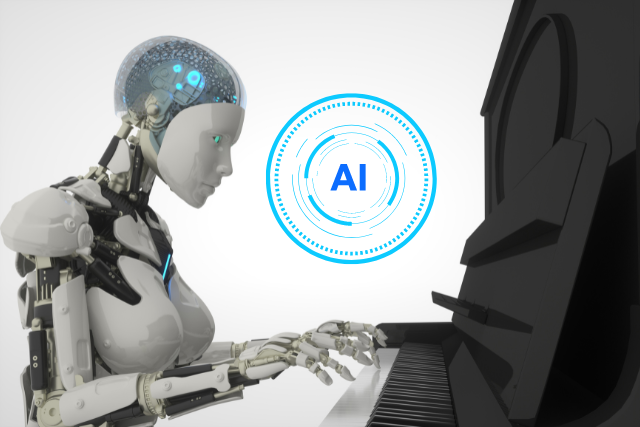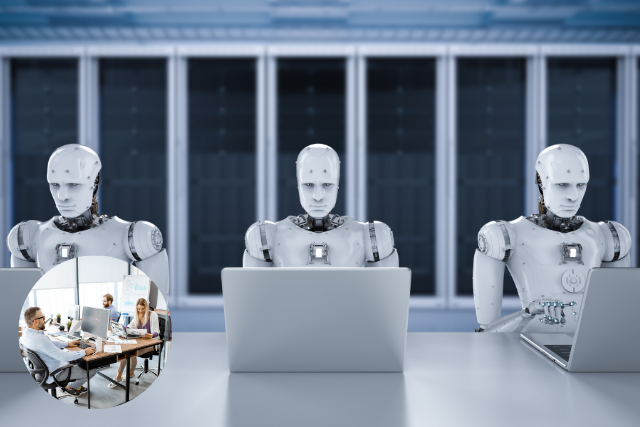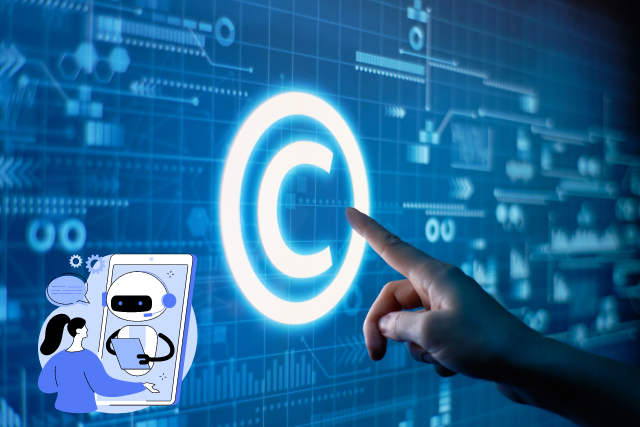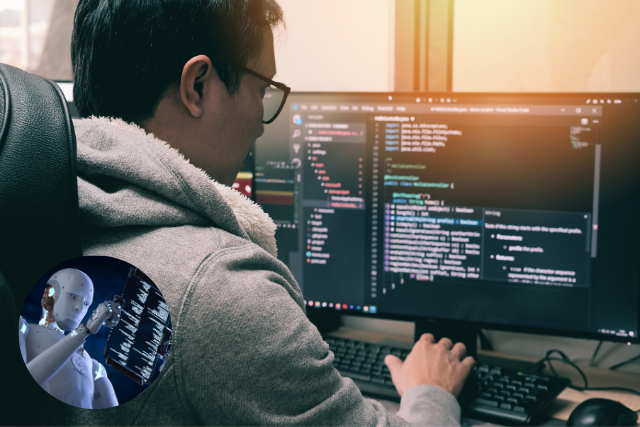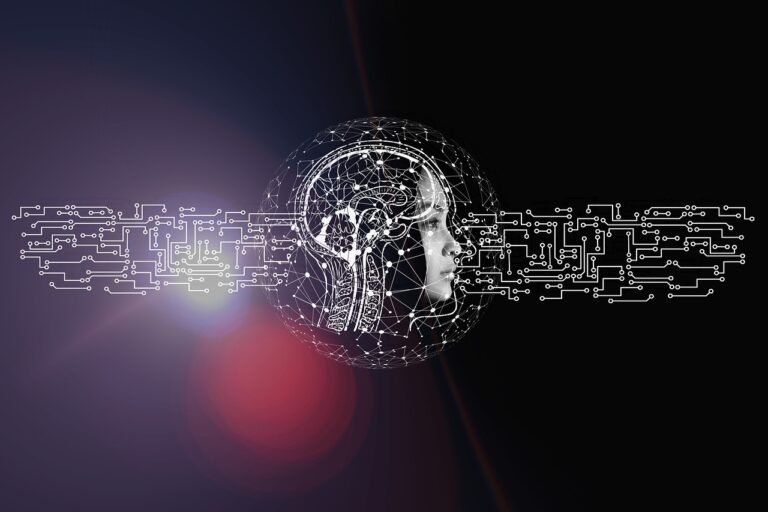You’re about to unleash the full potential of generative AI in music production. Machine learning algorithms can create intricate melodies, harmonies, and even entire compositions rivalling human creators.
AI models analyze musical patterns and relationships in vast datasets, learning to generate new musical content that adheres to learned patterns. You can use AI to create melodies, harmonies, drum patterns, or even entire compositions.
You can produce unique and compelling musical compositions by combining AI-generated elements with human creativity. Now, explore the vast possibilities of AI-powered music production and take your creative workflow to the next level.
Key Takeaways
- Generative AI models can create intricate melodies using techniques like sequence-to-sequence learning and generative adversarial networks (GANs).
- AI-generated melodies often exhibit characteristics like repetition, variation, and contrast, making them suitable for various music genres.
- AI algorithms can create context-aware chord progressions that complement the melody’s key, mode, and tonal structure, enhancing overall harmony.
- Combining AI-generated melodies and harmonies can accelerate the creative workflow and explore new musical ideas.
- Collaborating with AI tools can lead to innovative musical creations, freeing humans to focus on high-level artistic decisions.
History of AI in Music
Since the 1950s, computer scientists and musicians have been exploring the potential of artificial intelligence in music. This exploration led to the development of algorithms and systems to generate, manipulate, and interact with musical compositions.
You’ve likely encountered early AI-generated music experiments, such as Iannis Xenakis’ ‘Morsima-Amorsima’ (1962) or Lejaren Hiller’s ‘Illiac Suite’ (1957). These pioneers paved the way for more sophisticated systems, like David Cope’s Experiments in Musical Intelligence (EMI) in the 1980s.
As you immerse yourself in the history of AI in music, you’ll notice a gradual shift from rule-based systems to machine-learning approaches. This progression has enabled AI models to learn from vast datasets, generating more complex and coherent music.
Today, you can explore various AI-powered music tools, from plugin instruments to entire composition platforms. Understanding the evolution of AI in music will help you appreciate the capabilities and limitations of current generative AI models and how they can enhance your music production workflow.
How Generative AI Works
By analyzing vast datasets of musical patterns and relationships, generative AI models learn to recognize and replicate the underlying structures that govern various genres and styles of music. You’ll find that these models are typically based on deep learning architectures, such as recurrent neural networks (RNNs) and transformers.
These architectures are well-suited for processing sequential data like music. As you investigate further, you’ll see that the models are trained on extensive collections of audio files, MIDI files, or musical scores. This training allows them to identify patterns and relationships between notes, chords, and rhythms.
When you interact with a generative AI model, it uses this learned knowledge to generate new musical content, such as melodies or harmonies. The model’s output is often generated through sampling, where the model randomly selects elements from the learned patterns to create novel combinations.
This process enables the model to produce unique and coherent musical pieces that human composers can use as-is or further refine. By understanding how generative AI works, you’ll be better equipped to harness its potential in your music production workflow.
Music Composition With AI
You can now apply the knowledge you’ve gained about how generative AI models work to explore their capabilities in music composition. AI-generated musical elements can be used to augment or even create entire pieces.
By leveraging AI’s ability to process and analyze vast amounts of data, you can generate musical components such as chord progressions, basslines, and drum patterns. These components can be used to create complex and coherent musical structures.
| AI-Generated Element | Composition Application |
|---|---|
| Chord Progressions | Harmonic foundation for a song |
| Basslines | Rhythmic and melodic counterpoint |
| Drum Patterns | Percussive foundation and rhythmic interest |
These AI-generated elements can be used in various ways to enhance your composition. For instance, you can use AI-generated chord progressions as a starting point for your song and then build upon them with your melodies and harmonies.
Alternatively, you can use AI-generated basslines and drum patterns to add depth and rhythmic interest to your track. Combining AI-generated elements with your creative input allows you to create unique and compelling musical compositions that showcase the best of both human and artificial intelligence.
AI-Generated Melody Creation
Generative AI models can craft intricate, coherent melodies rivalling human compositions. This capability is thanks to their ability to analyze and learn from vast libraries of musical data.
You can input specific parameters, such as tempo, genre, and mood, and the AI will generate a unique melody that meets your requirements. These models use techniques like sequence-to-sequence learning and generative adversarial networks (GANs) to create both novel and coherent melodies.
When working with AI-generated melodies, you’ll find that they often exhibit characteristics like repetition, variation, and contrast – hallmarks of human-composed melodies. You can also experiment with different AI models, each with strengths and weaknesses, to create diverse and exciting melodies.
For instance, some models excel at generating catchy, pop-inspired melodies, while others produce more experimental, ambient soundscapes. By leveraging these AI tools, you can accelerate your creative workflow, explore new musical ideas, and even collaborate with machines to create something truly innovative.
Harmonizing With AI Algorithms
With AI-generated melodies, you’re ready to add harmonic depth and complexity. Leveraging AI algorithms can create rich, context-dependent chord progressions and basslines tailored to your melody’s unique characteristics.
These algorithms analyze your melody’s pitch, rhythm, and contour to generate harmonies that complement and enhance your original idea. Some key benefits of using AI for harmonization include:
- Context-aware chord progressions: AI algorithms can create chord progressions considering the melody’s key, mode, and tonal structure, ensuring a coherent and engaging harmonic landscape.
- Bassline generation: AI can create basslines that provide a solid foundation for your track, adding depth and energy to your music.
- Experimentation and variation: AI algorithms can generate multiple harmony options, allowing you to explore different creative directions and find the perfect fit for your song.
- Time-saving: By automating the harmonization process, you can focus on other aspects of music production, such as arrangement, mixing, and mastering.
- Inspiration and collaboration: AI can serve as a creative partner, providing new ideas and insights to spark inspiration and fuel your artistic vision.
Patterns in Music Generation
You’re likely aware that music is built on patterns, from the repetition of melodies to the structure of harmonies. AI algorithms can identify and replicate patterns in music generation, allowing them to create cohesive and engaging musical structures that resonate with listeners.
By analyzing vast music datasets, these algorithms can recognize rhythm, melody, and harmony patterns. They use this knowledge to generate new music that sounds authentic and coherent.
You can use AI algorithms to create patterns at multiple levels when generating music. For instance, you can use them to generate repetitive melodic phrases or to create harmonic progressions that follow familiar patterns.
You can also use AI to create larger-scale patterns, such as the structure of a song or the progression of a musical theme. By combining these patterns, you can create complex and engaging musical compositions that showcase the capabilities of AI-generated music.
As you experiment with AI-generated patterns, you’ll find they can be a powerful tool for creating music that resonates with listeners.
Collaborative Music Production
By integrating AI algorithms into the music production process, musicians and producers can tap into the creative potential of collaborative music production. Here, humans and machines work together to generate innovative sounds and push the boundaries of musical expression.
You can leverage AI’s capabilities to augment your creative workflow, freeing you up to focus on high-level artistic decisions. In a collaborative music production setup, you can:
- Use AI to generate ideas for melodies, chord progressions, or drum patterns, which you can refine and develop further.
- Feed AI-generated sounds and melodies into your existing workflow, combining the best of both worlds.
- Let AI handle tedious tasks like audio editing and mixing, freeing your time for more creative pursuits.
- Collaborate with AI on the composition of entire tracks, with the AI generating sections or even whole songs.
- Use AI to analyze and provide feedback on your music, helping you identify areas for improvement and refine your craft.
AI Music Tools and Software
Numerous AI music tools and software have emerged, offering a range of innovative features and functionalities. These enable musicians and producers to integrate artificial intelligence into their creative workflows.
You can now explore various options, from AI-powered plugins to standalone software, each with unique strengths and weaknesses. For instance, some tools allow you to generate melodies and harmonies based on machine learning algorithms, while others provide advanced audio editing capabilities.
As you immerse yourself in the world of AI music tools, you’ll discover platforms like Amper Music, AIVA, and Jukedeck. These platforms offer cloud-based music composition and production services, utilizing AI to create original music tracks, often in minutes.
You can also explore plugins like Melodyne, which uses AI to analyze and correct pitch and timing issues in vocal recordings. Consider your specific needs and goals when selecting an AI music tool or software.
Do you want to generate new melodies or improve existing audio tracks? Are you looking for a collaborative tool or a standalone solution? By understanding the capabilities and limitations of each option, you can harness the power of AI to elevate your music production skills and take your creative projects to the next level.
Famous AI-Generated Tracks
As AI-generated music continues to gain traction, several tracks have made headlines and sparked debate about the role of artificial intelligence in music production. You might be surprised that some of these tracks have even topped the charts or been featured in major films and commercials.
Here are some notable examples:
- Amper Music’s “Break Free”: This AI-generated track was used in a 2018 Coca-Cola commercial, showcasing the potential of AI music in advertising.
- Daddy’s Car: This Beatles-inspired track was created by French music composer Benoît Carré using AI software, sparking debate about the authenticity of AI-generated music.
- Hello World: This album, composed entirely by AI, was released in 2016 and features a range of genres, from electronic to pop.
- Jukedeck’s “Gods”: This AI-generated track was used in a 2017 trailer for the video game “Shadow of the Colossus,” demonstrating the potential of AI music in the gaming industry.
- Flow Machines: This EU-funded project has produced numerous AI-generated tracks, including a song that topped the French charts in 2017.
These examples illustrate the growing presence of AI-generated music in the industry and the ongoing debate about its role in music production.
Creative Freedom With AI
With AI-generated music tools, you can bypass traditional creative constraints. This unlocks unprecedented freedom to experiment with unique sounds, melodies, and rhythms.
Your musical knowledge or skill level no longer binds you, as AI algorithms can generate novel ideas and patterns that might have taken years to develop through traditional practice. This freedom allows you to explore uncharted territories, from unusual time signatures to innovative instrumentation.
You can also iterate rapidly, testing and refining ideas without the tedium of manual experimentation. Moreover, AI-generated music tools provide an objective perspective untainted by personal biases or emotional attachments.
This enables you to make data-driven decisions, analyzing and refining your work precisely. You can focus on the creative aspects of music production while AI handles the tedious tasks, such as chord progression generation or drum pattern creation.
By leveraging AI’s capabilities, you can unlock new levels of creative potential, pushing the boundaries of what’s possible in music production. The possibilities are endless, and the freedom to explore them is yours to seize.
Human Emotion in AI Music
How do you infuse human emotion into AI-generated music, a medium often perceived lacking the emotional depth of its human-created counterpart? As a music producer, you know that evoking emotions is vital to creating engaging and memorable music.
While AI algorithms can easily generate melodies and harmonies, translating human emotions into code can be demanding. You can employ various techniques to inject emotional depth into your AI-generated music to achieve this. Here are a few strategies to ponder:
- Use emotional annotation: Label your training data with emotional tags, enabling the AI to understand the emotional context of the music.
- Incorporate human feedback: Collaborate with human musicians or listeners to provide feedback on the emotional resonance of the generated music.
- Experiment with timbre and texture: Manipulate the tone and timbre of the instruments to convey specific emotions, such as warmth or nostalgia.
- Play with dynamics and tempo: Vary the volume, tempo, and rhythm to create emotional tension and release.
- Draw from personal experiences: Use your emotional experiences as inspiration, and try to convey those emotions through the music.
Overcoming Creative Blocks
One major obstacle you’ll inevitably face when working with generative AI for music production is overcoming creative blocks that can stifle your artistic vision. These blocks can occur when you’re overly reliant on AI-generated ideas, leading to a lack of originality and inspiration.
To overcome this, balancing human creativity and AI-generated suggestions is crucial. Try setting constraints for the AI, such as limiting the number of generated ideas or specifying specific chord progressions, to encourage more innovative and diverse results.
Another approach is to use AI as a catalyst for your creative ideas. Instead of relying solely on AI-generated melodies, use them as a starting point and build upon them with your unique flair. This collaboration between humans and AI can lead to exciting and unexpected outcomes.
Additionally, don’t be afraid to take breaks and step away from your project. Sometimes, clearing your mind and returning to your work with a fresh perspective can help you break creative barriers. Adopting these strategies, you can overcome creative blocks and access the full potential of generative AI for music production.
AI Music in Different Genres
Explore the vast possibilities of AI music in various genres, from electronic dance music (EDM) to classical compositions. Generative algorithms can be fine-tuned to mimic distinct styles and create unique fusions.
You’ll discover that AI can produce eerily similar music to human creations. It can even push boundaries by blending styles in innovative ways.
- Electronic/Pop: AI-generated beats and melodies can create infectious dance tracks while allowing for experimentation with unusual sound designs and rhythms.
- Classical: Generative models can compose complex, intricate pieces that rival those of human composers, perfect for film scores or concert halls.
- Jazz/Improvisation: AI can improvise solos and even entire songs, responding to changing harmonies and melodies in real time.
- Hip-Hop/Rap: AI-generated beats and hooks can help producers create fresh, modern sounds while also assisting with lyrics and vocal processing.
- Ambient/Experimental: AI can generate atmospheric soundscapes and textures, perfect for film, video games, or meditation.
As you immerse yourself in these genres, you’ll find that AI music production tools offer endless opportunities for creativity and innovation.
Future of Music Production AI
As you venture into the domain of AI music production, you’ll likely wonder what the future holds for this rapidly evolving technology and whether it will ultimately augment human creativity or revolutionize the music industry altogether. The possibilities are vast, with AI-generated music potentially transforming the way we create, produce, and consume music.
One promising development area is the integration of AI with virtual and augmented reality technologies. This could enable immersive music experiences that blur the lines between creator and listener.
Furthermore, AI-driven music production could democratize the industry, providing access to high-quality music creation tools for aspiring producers and artists. Advances in machine learning algorithms will also play a pivotal role in shaping the future of AI music production.
As these algorithms improve, AI systems can learn from vast amounts of data, generating increasingly sophisticated and nuanced music. You can expect AI-generated music to infiltrate various aspects of the industry, from film scores to live performances, and even influence how we think about music composition and theory.
Ethical Considerations of AI
You’ll need to muse upon the ethical implications of relying on AI-generated music, particularly regarding ownership and authorship rights. The technology’s increasing sophistication raises questions about the role of human creativity in the music production process.
As you immerse yourself deeper into the world of AI music generation, it is crucial to contemplate the ethical consequences of this technology.
Authorship and ownership: Who should be credited as the author of AI-generated music? Should it be the human creator of the algorithm or the algorithm itself?
Originality and creativity: Does AI-generated music qualify as original, or is it simply a combination of existing ideas?
Job displacement: Will AI-generated music replace human musicians and composers or augment their abilities?
Accountability: Who is accountable for any errors or biases in AI-generated music?
Transparency: Should AI-generated music be labelled as such, or is it acceptable to present it as human-created?
Frequently Asked Questions
Can AI-Generated Music Be Copyrighted or Owned by Humans?
You’re wondering if AI-generated music can be copyrighted or owned by humans. The answer is yes, as the U.S. Copyright Office considers AI-generated works to be human-owned, but this legal landscape is rapidly evolving.
Do AI Music Tools Require Musical Knowledge to Operate?
When operating AI music tools, you don’t necessarily need extensive musical knowledge, but having a basic understanding of music theory and composition principles can help you effectively guide the AI’s creative process.
Can AI Algorithms Mimic Specific Music Styles or Eras?
You can train AI algorithms to mimic specific music styles or eras by feeding them large datasets of labelled examples, allowing them to learn patterns and characteristics unique to that style or era.
Will AI Replace Human Musicians and Music Producers Entirely?
You’ll likely see AI augmenting human musicians and producers rather than replacing them entirely. AI excels in pattern recognition and generation but lacks human creativity, emotional depth, and nuanced decision-making.
Are AI-Generated Tracks Suitable for Commercial Use or Radio Airplay?
You’ll find AI-generated tracks suitable for commercial use or radio airplay, but only if you thoroughly review and refine them, ensuring they meet industry standards and potentially collaborating with human musicians to add unique touches.
How Can AI Be Used to Enhance Music Production Workflows?
AI can enhance music production workflows by automating tedious tasks, providing new creative ideas, and allowing for rapid experimentation and iteration, thus enabling musicians to focus more on the artistic aspects of their work.
Conclusion
So, that’s the vast potential of generative AI in music production, from its historical roots to its current capabilities. By leveraging AI algorithms, musicians can create innovative melodies and harmonies and even overcome creative blocks.
As AI music production continues to evolve, it’s essential to consider the ethical implications. With great power comes great responsibility, and it’s up to you to shape the future of music production with AI.

